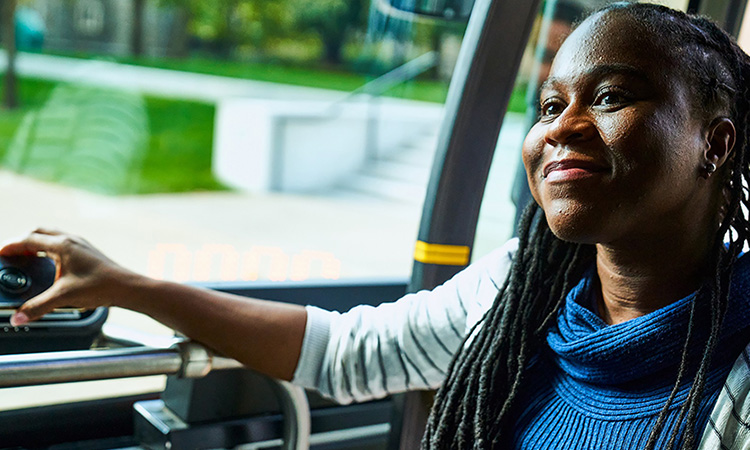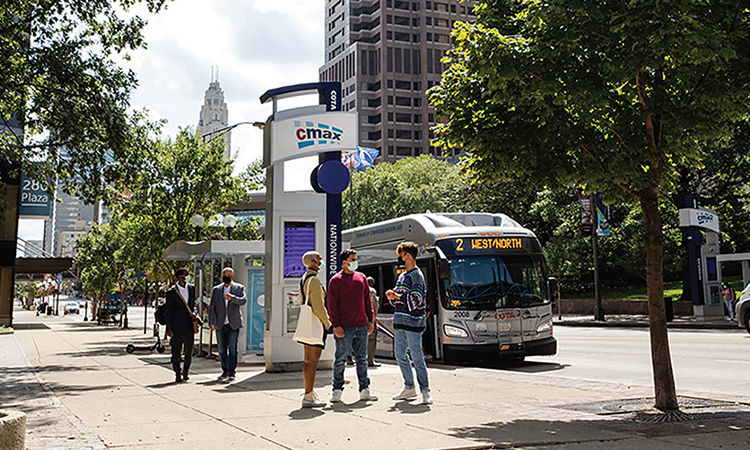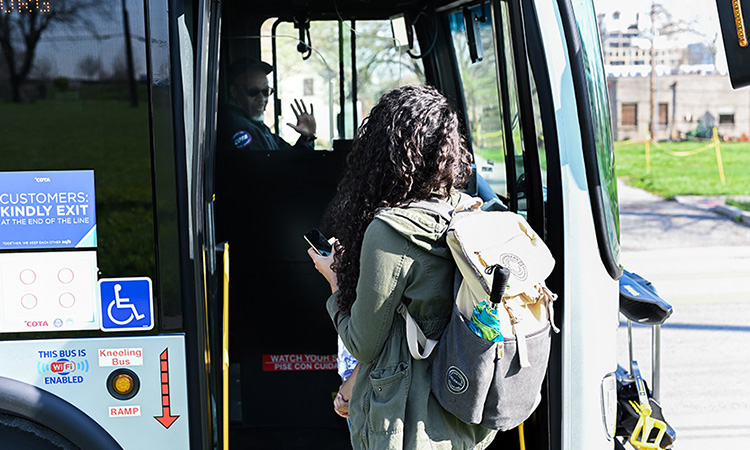Forming prosperous communities through improved transport equity
- Like
- Digg
- Del
- Tumblr
- VKontakte
- Buffer
- Love This
- Odnoklassniki
- Meneame
- Blogger
- Amazon
- Yahoo Mail
- Gmail
- AOL
- Newsvine
- HackerNews
- Evernote
- MySpace
- Mail.ru
- Viadeo
- Line
- Comments
- Yummly
- SMS
- Viber
- Telegram
- Subscribe
- Skype
- Facebook Messenger
- Kakao
- LiveJournal
- Yammer
- Edgar
- Fintel
- Mix
- Instapaper
- Copy Link
Posted: 5 June 2023 | Monica Jones - Central Ohio Transit Authority | No comments yet
Monica Jones, Chief Equity Officer at the Central Ohio Transit Authority, discusses the importance of acknowledging the history of racism in public transportation and neighbourhood development and shares how COTA is working to improve equity and diversity within transport through a more inclusive approach.


Credit: Central Ohio Transit Authority
It’s more critical than ever for COTA to take the necessary steps to ensure that transport across the region will meet all of Central Ohio residents’ needs”
Public transit can help to connect a city in both the figurative and literal sense. Erol Ozan, a professor at East Carolina University, says, “You cannot understand a city without using its public transportation system.” That’s true of systems across the country and right here in the Columbus, Ohio Region.
With a service area of 1.4 million residents, the Central Ohio Transit Authority (COTA) had provided more than 10 million passenger trips in 2022. The Columbus Region is bracing for a population explosion, which is now expected to double to more than three million residents by 2050. In the short-term, our region is preparing to welcome Intel, which is making a $20 billion investment and creating about 7,000 construction jobs in Autumn 2023. That is why it’s more critical than ever for COTA to take the necessary steps to ensure that transportation across the region will meet all of Central Ohio residents’ needs and will not leave the region’s most vulnerable residents in the rear view mirror.
Addressing racial inequalities in transport
Public transportation has not always been a force for connecting us. At times, it has been a force for division”
Unfortunately, public transportation has not always been a force for connecting us. At times, it has been a force for division. America’s history is littered with racism and discrimination, and the public transportation sector often played a part in that. It is not lost on us that perhaps the most iconic moment in American civil rights history took place in 1955 with Rosa Parks on a bus – and the transit agency in the story was not the hero, but the villain.
The racial disparities that we see today in neighbourhoods are not there by accident, but by design. Examples of the policies of the past that continue to cast a large shadow today include redlining, which is providing – or denying – personal and business loans to customers based on their zip code and, ultimately, their race. Many neighbourhoods populated by Black residents, including those who were financially secure or wealthy, were stigmatised as too high-risk to receive loans.
Meanwhile, highway designs cut through and destroyed Black and brown neighbourhoods while circumnavigating areas of affluence. The development of suburbs moved reliable jobs from city centres to municipalities 20 to 30 miles away – and made them inaccessible to residents who did not own cars.


Credit: Central Ohio Transit Authority
Acknowledging the history of racism in public transportation and neighbourhood development presents us with the opportunity to place equity and diversity inclusion in the centre moving forward. Now that we understand how communities were intentionally disconnected and disinvested through policies, the conversation can focus on equitable solutions tied to policies.
Nationally, such policies include the Biden Administration’s Justice40 Initiative, which directs at least 40% of climate and infrastructure investment benefits to disadvantaged communities to address high levels of pollution, chronic disinvestment and lack of access to capital in communities of colour and low-income areas.
On the local level, many cities, including Columbus, are implementing housing policies that focus on high-density developments that, at best, put disadvantaged communities closer to employment opportunities and at least allow them to live near transit centres that make work more accessible.
At COTA, we introduced fare-capping that corrects a historic inequity in transit fares. Instead of offering a discount to those who can afford a monthly pass, customers now never pay more than $4.50 per day, or $62 per calendar month, potentially saving hundreds of dollars annually. The goal is to help families to pay less for transportation in order to help them keep more economic resources in their pockets.
Supporting the next generation
COTA is also taking great strides to set up our local youth for success. COTA works with the Columbus City Schools system to ensure that its students can have transit access. However, this programme is more than just attending classes. COTA provides students with unlimited access to transportation seven days a week, allowing them to get home from after-school activities, have reliable transportation to part-time jobs, or join friends for a day at a museum, cinema or the Columbus Zoo and Aquarium. We all know that there is learning outside of the classroom, and this programme gives students access beyond just school, which is vital for families with limited means. We’re helping a whole generation of students who use public transit now become lifelong users of our transit system.


Credit: Central Ohio Transit Authority
Fighting inequality to support sustainability
Our past is how we ended up in the present. The decisions that we make today will affect the future”
Our past is how we ended up in the present. The decisions that we make today will affect the future. All of my colleagues at COTA, from the President/CEO down, look at sustainability through the lens of equity, diversity and inclusion. COTA is committed to reducing the carbon footprint in neighbourhoods where kids have a higher rate of asthma and other breathing challenges because of pollution.
Due to the previously discussed historical injustices, climate change disproportionately impacts African Americans, Indigenous people and lower socioeconomic communities. COTA is doing its part to help the City of Columbus to achieve its 2050 carbon neutral goals, which COTA began in 2013. We are also investing in an all-electric fleet, and are committed to retiring all diesel transit vehicles by 2025. COTA plans to be net zero carbon neutral by 2045 by purchasing electric buses and exploring other zero-emission technologies, including hydrogen fuel cell vehicles.
The LinkUs Mobility Initiative: The future of transport in Central Ohio
COTA is helping to lead the effort to make Central Ohio a prosperous region for the entire community, regardless of race or zip code”
The LinkUs Mobility Initiative is potentially the biggest investment that could be made in the Central Ohio region. It is a multi-billion dollar project that will expand COTA’s transit system, launch rapid transit corridors, improve transit connections and build transit-supportive infrastructure, including bike lanes, pavements, crosswalks, roads and greenways. Expanded transit infrastructure means that people will have equitable mobility access to social and economic prosperity.
The late U.S. Congressman Elijah Cummings once said, “Our decisions about transportation determine much more than where roads or bridges or tunnels or rail lines will be built. They determine the connections and barriers that people will encounter in their daily lives, and thus how hard or easy it will be for people to get where they need and want to go.” COTA is helping to lead the effort to make Central Ohio a prosperous region for the entire community, regardless of race or zip code. The policies that we enact now will determine whether or not we fulfil our equity obligations.


Related topics
Accessibility, Active travel, Infrastructure & Urban Planning, Mobility Services, Passenger Experience, Public Transport
Issue
Issue 2 2023
Related modes
Bikes & Scooters, Bus & Coach, Rail
Related cities
Ohio
Related countries
United States
Related organisations
Central Ohio Transit Authority (COTA)
Related people
Elijah Cummings, Monica Jones








